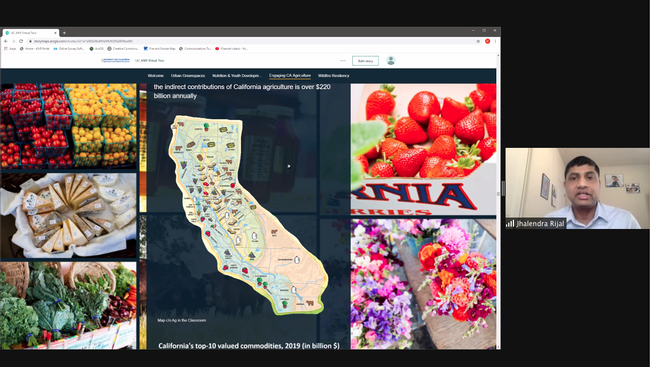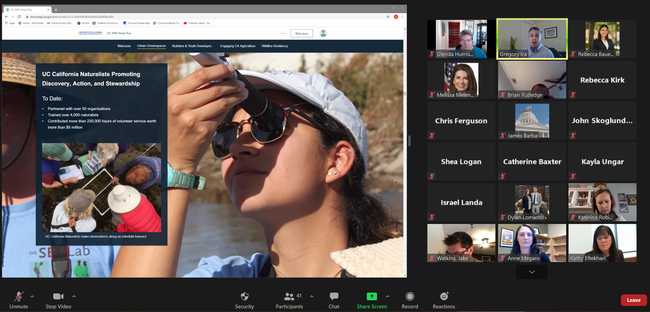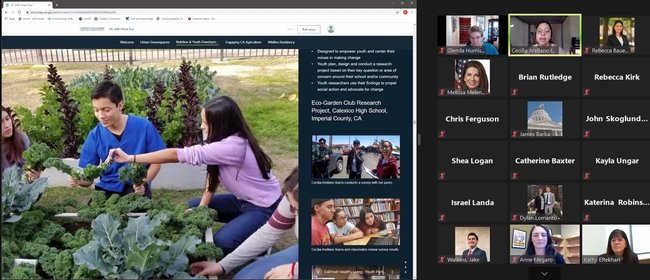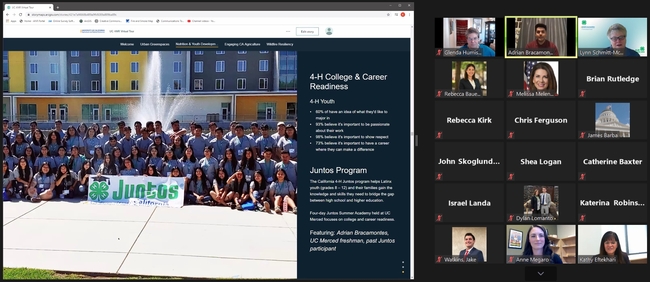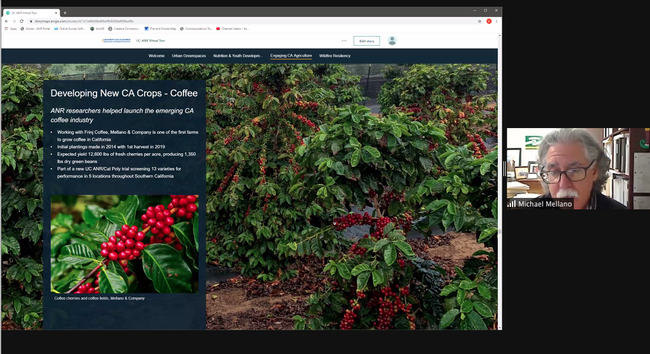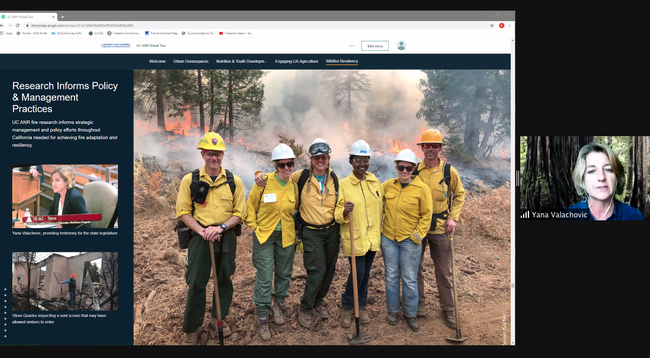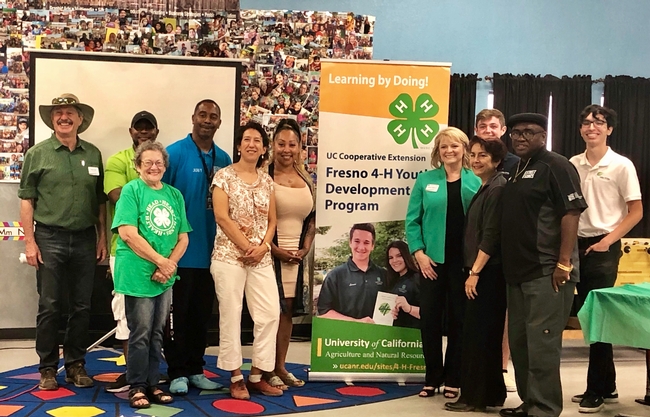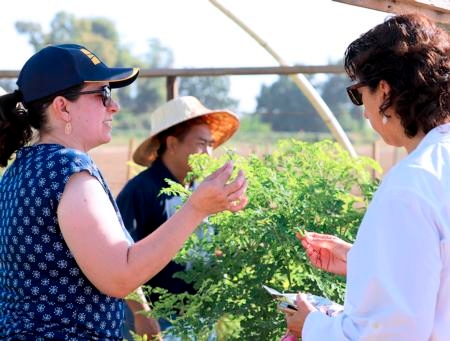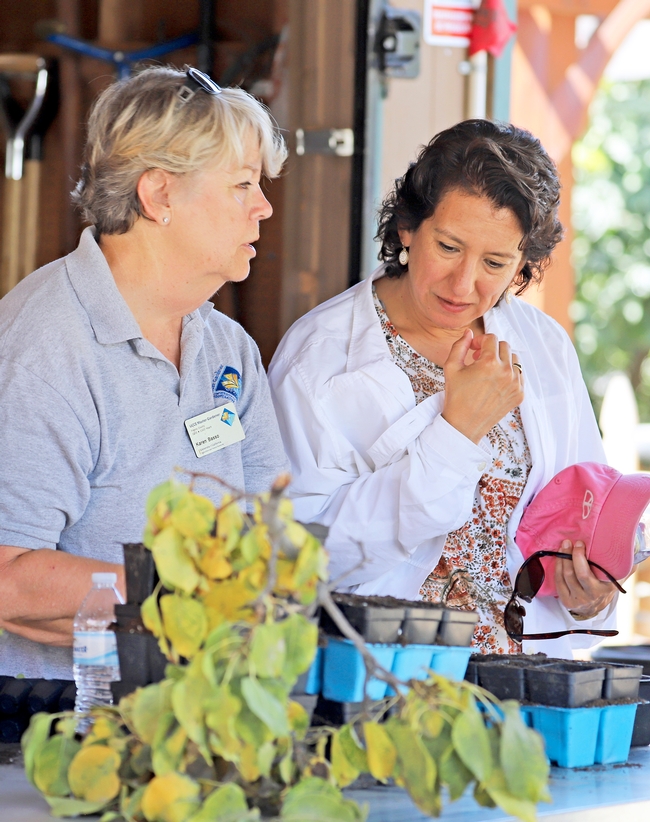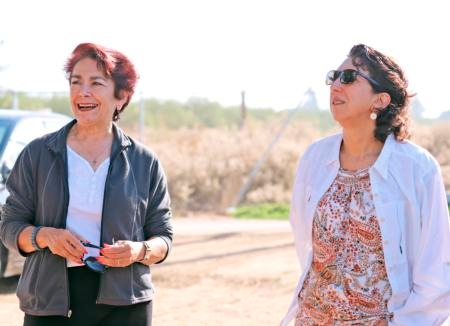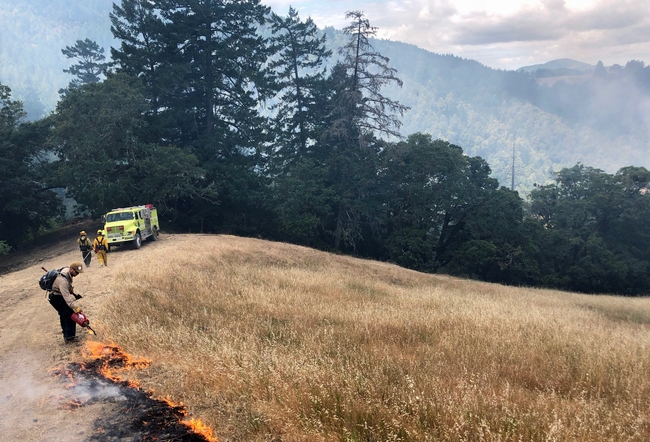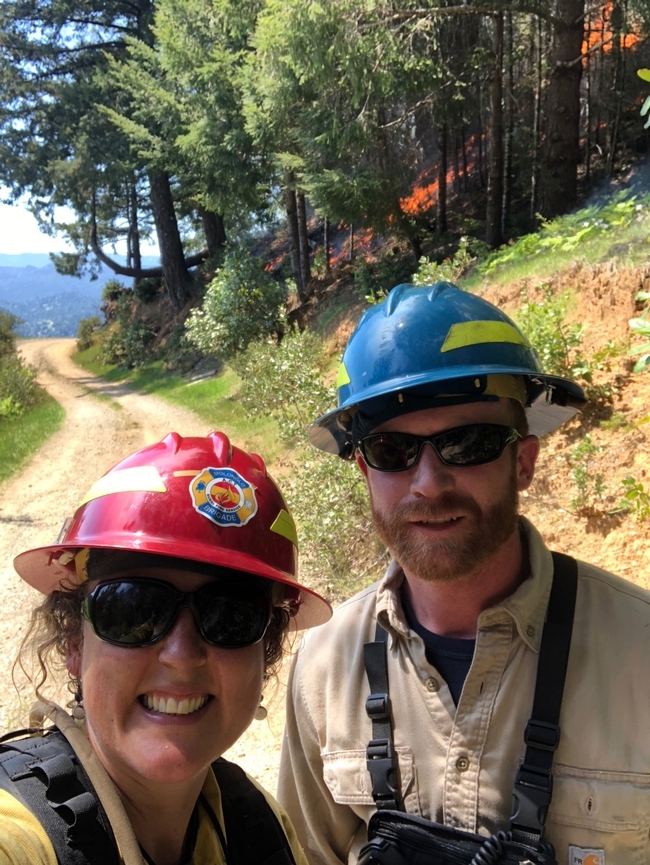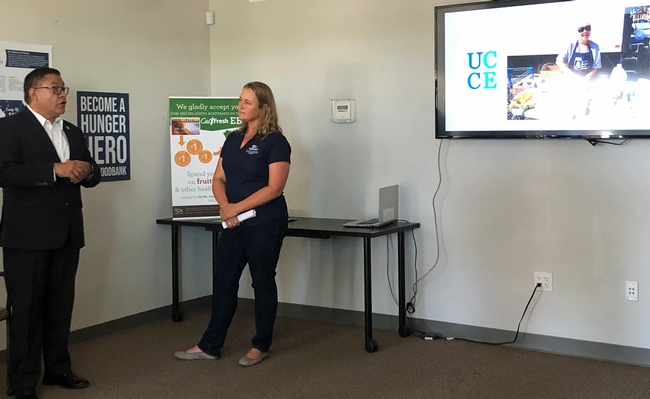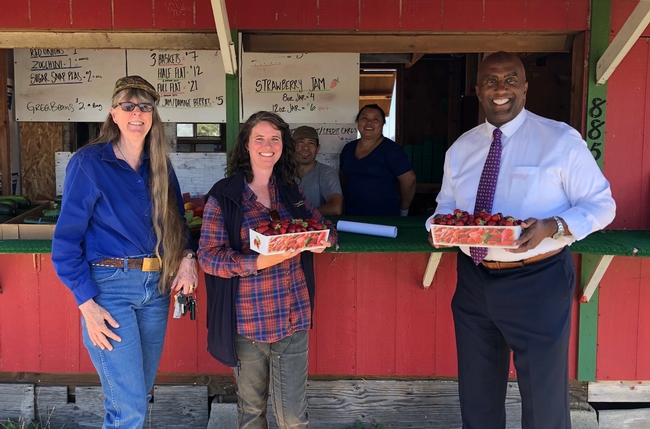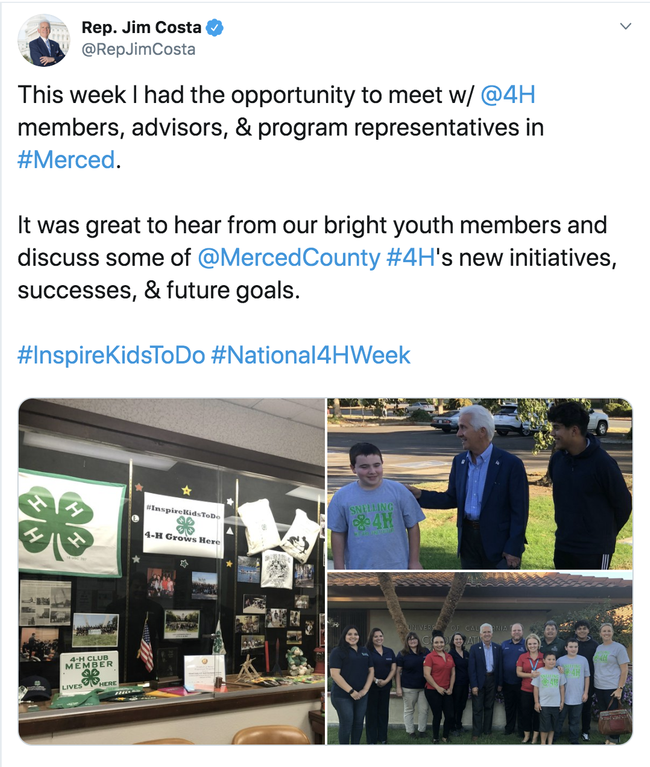Posts Tagged: advocacy
Legislators take virtual tour of UC ANR
VP Glenda Humiston led California state legislators, their staff members and other policymakers on a virtual tour of UC ANR on Nov. 20.
Humiston welcomed Assemblymember Rebecca Bauer-Kahan, Assemblymember Robert Rivas, Senator Melissa Melendez and staff of Senator/Pro Tem Toni Atkins, Senators Nancy Skinner and Henry Stern; staff of Assemblymembers Heath Flora and Monique Limon and members of the governor's office and administration.
The tour opened with the We are UC ANR video and a map of UC ANR locations for background. Using short videos and photos, statewide program directors and UC ANR stakeholders showed the policymakers many of the ways UC ANR serves Californians. Other “tour stops” included highlights of UC ANR's impact on urban greenspaces, nutrition and youth development, California agriculture and wildfire resiliency.
Missy Gable, director of the UC Master Gardener Program, kicked off the urban greenspaces presentations by describing the contributions of volunteers. She discussed how the Master Gardener Program has changed during the COVID-19 constraints, noting a surge in the public's interest in gardening and the creation of a virtual classroom for the public in Senator Stern's district.
Jim Farrar, director of the Integrated Pest Management Program, explained that IPM helps all Californians control pests, both agricultural and urban pests. He described the work being done to manage red imported fire ant, bed bugs and invasive shot hole borers.
Greg Ira, director of the California Naturalist Program, said Cal Nat has expanded UC ANR's audience to include a younger, more diverse population in metropolitan areas. He explained how Cal Nat partners with organizations that deliver the course, which opens participants' eyes to the environment and stewardship as paths to green jobs.
Lorene Ritchie, director of the Nutrition Policy Institute, kicked off the nutrition and youth development section of the tour by describing how NPI research has informed policies such as removing chips and soda from schools, the healthy beverages law requiring water be made available to children in all licensed child day-care facilities in California, and the U.S. dietary guidelines.
Kamal Khaira, director of CalFresh Healthy Living, UC, talked about how CalFresh and EFNEP nutrition educators teach people in English and Spanish how to shop for and prepare healthful foods on a limited budget to prevent chronic diseases.
Cecilia Arellano Ibarra, now a UC Davis student, enthusiastically described how she interviewed fellow Calexico High School students to find out why they bought junk food instead of the food served by the school as part of her eco-garden club research project. Based on the student responses, she worked with CalFresh Healthy Living, UC to start a school garden and advocate for a farm-to-school program to provide fresh produce.
Lynn Schmitt-McQuitty, director of the 4-H Youth Development Program, described the 4-H Juntos program, which bridges the gap between high school and higher education with a four-day college and career readiness workshop. UC Merced student Adrian Bracamontes said attending Juntos helped him get scholarships and helped his parents understand the process.
Jhalendra Rijal, area IPM advisor, launched the California agriculture section of the tour by giving guests an overview of the size and scope of California's agricultural commodities. He then talked about the value of the state's nut crops and summarized UC ANR's research to manage navel orangeworm, which attacks almond, walnut and pistachio crops.
Ashraf El-Kereamy, UCCE specialist and director of Lindcove Research and Extension Center, described the citrus breeding and pest management research being done at the REC. For example, the popular Tango mandarin was developed at Lindcove REC with UC Riverside breeders. He also discussed research on Asian citrus psyllid and huanglongbing disease.
Ruth Dahlquist-Willard, small farms advisor, described how UC ANR promotes economic success by developing new crops. Hmong farmers in Fresno County growing the “superfood” moringa consult Dahlquist-Willard about production and regulations while farm advisor Konrad Mathesius is studying malting barley for new flavors of craft beer.
Mike Mellano, third-generation flower grower in San Diego County, UC President's Advisory Commission member and California representative for the Council for Agricultural Research, Extension, and Teaching, told the legislators that his business may not exist as it is today without UC ANR's research to help him compete in the world economy. He has diversified his operations to include agritourism with the Flower Fields at Carlsbad Ranch and growing coffee.
Betsy Karle, dairy advisor, described her work with the state's number one commodity to meet climate goals for methane emissions. She also discussed UC ANR's partnership with the California Department of Food and Agriculture to educate farmers about adapting to climate change.
Yana Valachovic, forestry advisor and UCCE director in Humboldt and Del Norte counties, explained how elected officials can look to UC research to inform policy on issues such as wildfire.
Stephanie Larson, livestock and range advisor and UCCE director in Sonoma County, highlighted UC Cooperative Extension's ability to pivot quickly to address emerging issues of clientele. For example, when Sonoma County residents called asking if food in their gardens was safe to eat after a wildfire, UCCE harvested food from gardens and tested it. UC Davis School of Veterinary Medicine tested eggs from backyard chickens for postfire food safety. They found the eggs and produce were generally safe to eat.
The tour was accompanied by a “learning box” with 11 different items related to the various tour stops for participants to taste, feel and explore. To conclude the virtual tour, Humiston told the legislators, “This is only a fraction of what UC ANR does. We've got hundreds of researchers. When you need information, reach out to us.”
Two similar virtual tours for UC regents and President Drake will be held on Dec. 2 and Dec. 8, respectively. A self-guided version of the virtual tour will be posted online following the last live tour.
Regent Estolano, Senator Caballero tour UCCE Fresno
“UC ANR touches the lives of thousands of people in rural communities and urban centers alike,” said state Senator Anna Caballero, after meeting UC Cooperative Extension staff and stakeholders in Fresno County. Caballero joined UC Regent Cecilia Estolano for a tour Sept. 25 to see results of ANR's work with small-scale farmers, 4-H youth and UC Master Gardener volunteers.
“On my tour, I saw how ANR is a valuable partner across generations and communities for Californians who grow our food, and green our neighborhoods,” Estolano said. “From urban 4-H chapters to Master Gardeners to culturally connected crop advisors and nutritional instructors, ANR is keeping California on the leading edge of agriculture, health and healing.”
Joined by Vice Provost Mark Bell, UCCE Fresno County Director Karmjot Randhawa, and Anne Megaro, government and community relations director, Caballero and Estolano began the tour with a visit to the Thao family farm, where they learned about specialty crops – such as jujubes and moringa – grown in the area by Southeast Asian farmers. UCCE farm advisor Ruth Dahlquist-Willard described growing and marketing moringa and her work to help bring resources to disadvantaged farmers to help improve their prosperity. Michael Yang, UCCE Hmong agricultural assistant, talked about delivering UCCE information to farmers in Hmong via his radio program.
Next, they visited Street Saints, a program of the Fresno Economic Opportunities Commission, and learned how they created an afterschool program to keep low-resource youth in Southwest Fresno safe. The Street Saints, who partnered with 4-H, described for the senator and regent how they promote healthy choices to deter young people from engaging in gang activity in their urban setting. Using 4-H's evidence-based curricula, Street Saints offers a safe place for youth after school where participating youth develop employment skills through 4-H activities such as sewing classes, STEM Teen Teachers, “Mindful Me” to improve physical and emotional health, and working in a community garden.
“It was exciting to see the interaction between the senator and regent with the UCCE stakeholders,” Randhawa said. “Both seemed really engaged in the work and asked questions. It's vital for them to see how we engage with the community and how the community amplifies the research and support we provide. They met small farmers and 4-H members who have built businesses based on their work with 4-H and Cooperative Extension. They met with Master Gardeners. It was fantastic for them to experience, rather than be told, how we deliver ANR's mission.”
Megaro got the impression Caballero and Estolano enjoyed meeting some of the Californians who have bettered their lives by participating in ANR programs.
“I think they both knew us mostly for our rural agricultural work, but this tour really showed them how we're active and present in urban communities to effect change and how we partner with community-based organizations to further our reach.” Megaro said. “We also talked about how the sites we visited were just one example of the programs and services we provide throughout the state, and how we are looking to increase resources so we can build out our programs to serve more people.”
At UCCE’s suggestion, Humboldt waives air-quality fees for public benefit burning
“I thought you all might enjoy this bit of good news from Humboldt County. Yesterday reminded me of the important role we at UCCE can play in these types of local issues,” wrote Lenya Quinn-Davidson, UCCE area fire advisor in Humboldt County.
Concerned about habitat loss and fuel buildup on private lands in Humboldt County, Quinn-Davidson and Jeff Stackhouse, UCCE livestock and natural resources advisor, recently formed a Prescribed Burn Association.
Thanks to Senate Bill 1260, which was signed into law last year, air districts are receiving grants from the California Air Resources Board to support local prescribed fire programs.
Stackhouse and Quinn-Davidson attended the North Coast Unified Air Quality Management District Board meeting Sept. 18 in Weaverville to suggest their district subsidize the air quality permit fees for prescribed burners.
“Our district has decided to use some of these grant funds to subsidize air quality permit fees for prescribed burners in the district. This is welcome news to those of us with the PBA who have been working for the last year to alleviate air quality permit fees, which can be $250 to $1250 for bigger projects. For our PBA burns, air quality permit fees are one of our biggest project costs, and now those fees will be waived.”
The air board's original plan was to subsidize projects with a focus on wildfire risk reduction. At the meeting, she and Stackhouse encouraged them to broaden the scope and include all projects that have a public benefit, including burns focused on habitat restoration, range improvement, forest improvement, cultural resources, etc., in addition to fuels reduction.
“We suggested that they tie the subsidy program to Public Resources Code 4475, which was amended through SB1260 to include an expanded definition of ‘public benefit burning.' They accepted our suggestion and amended the rule to reflect this broader suite of project types, which covers most of the great burning we're all doing in the North Coast: oak woodland restoration, medusahead/starthistle/blackberry control, coyote brush/coastal rangeland/prairie burning, understory fuels reduction, etc. With this cost relieved, we can start thinking about planning more projects and bigger projects! Yesterday, a 300-acre burn would have cost $1,250 (permit) + $65 (smoke management plan). As of today, those costs will be $0.”
The district's proposal also recommended excluding federal agencies and timber companies from the subsidy program, but Quinn-Davidson and Stackhouse asserted that any entity doing work that benefits the public should have equal access to the subsidy. In response, the Board voted to expand the program to include federal agencies and timber companies.
“Based on what air district staff said at the meeting, it sounded like this would save landowners about $14,000 to $18,000 per year in fees district-wide. I think it'll be even more than that in the coming years, with all the interest we have in prescribed fire,” Quinn-Davidson said.
“We're still working with the district to think about longer term solutions to their fee structure, but in the meantime, this is a fabulous step in the right direction!” Quinn-Davidson said.
Congressman Carbajal tours UCCE projects in SLO and Santa Barbara
The UCCE team in San Luis Obispo and Santa Barbara counties met with Congressman Salud Carbajal and his team twice in the past few weeks. On Aug. 20, Jeremy Tittle, the congressman's chief of staff, and Erin Sandler, the congressman's scheduler, visited. The congressional staff met with UCCE advisors, office manager, and director to learn more about UCCE research and programming.
UCCE advisor Ben Faber led a tour of research and education collaborations at Cal Poly, sharing research occurring on pomegranates, blueberries and other crops. In the afternoon, UCCE advisor Mark Battany led a tour at Wolff Vineyard, discussing research on how climate conditions relate to frost and water management.
The following week, Katherine Soule, UCCE director, met with Congressman Carbajal and project collaborators to discuss the outcomes and success of a USDA Community Food Project grant. On Sept. 5, the congressman visited with the project partners at the Food Bank Coalition of San Luis Obispo County.
Community partners described their contributions to the project, including UCCE's efforts to reduce food waste, increase awareness of local food systems, and maximize limited food resources through the UC Master Food Preserver Program. For this project, UC Master Food Preservers teach low-cost, safe, home food preservation methods to clientele receiving food at food bank distribution sites. During this meeting, the partners also discussed the San Luis Obispo County CalFresh Alliance's objective to increase CalFresh participation in the county.
San Luis Obispo County currently has one of the lowest CalFresh participation rates in the state so the partners have been working together to identify and address barriers to participation. Carbajal shared his concerns about the low rates of participation and his commitment to working to address food insecurity in the region.
These successful visits led Carbajal's team to schedule a meeting with 4-H youth, families and volunteers in San Luis Obispo and Santa Barbara counties in the next few months.
Advocacy is about building relationships
How do you achieve this? Communicate with all audiences throughout the year, not just during times of need. This helps form relationships as well as a deeper understanding of what it is that you do and how your work impacts the local community. This helps build a lasting relationship and a desire to support your research, programming, and services.
Many of our stakeholders know us through one program. By educating them about how our programs and academics work together – such as Master Gardener volunteers extending UC IPM information to the public or scientists with complementary expertise working together to address issues – people gain an appreciation for the value of UC ANR as a whole, not just individual programs. It's an impressive value proposition and it makes a difference in the lives of all Californians.
How should you educate elected officials?
As university employees, we may indicate our needs and ask for support with many audiences (e.g. funding organizations, boards of supervisors, donors, etc.) but we must take into consideration other factors when talking to elected state or federal officials or their staff members.
We can, and should, educate and inform elected state and federal officials and their staff of the work UC ANR does in their districts. However, we cannot take positions on bills or ask for budgetary support without the expressed consent from the UC Office of the President. Only the regents, who have delegated authority to President Napolitano, can determine UC's official position on legislative issues.
So, what can you do if you can't ask for money?
Share the impact of your work. Be specific! Tell a story and use UC ANR's public value statements to guide you. Sometimes a personal story about an individual who benefited from your work is easier to remember, and more moving, than total program impact to an entire community. For example, talk about your work solving a problem with a specific farmer and how it improved their bottom line, share a 4-H youth project, talk about working with a specific community partner and describe how you worked together to achieve a shared goal. Did you promote economic prosperity, develop a qualified workforce, or promote healthy people and communities? Did your partners save money? Did more 4-H youth go to college? Did participants lead healthier lives?
If we fine-tune the way we message our story and impacts, we can ensure that UC ANR will become widely known as the face of UC in communities throughout California.
For more information, see my one-pager at http://ucanr.edu/sites/Professional_Development/files/293044.pdf. Feel free to contact me at (530) 750-1218 or ammegaro@ucanr.edu.

